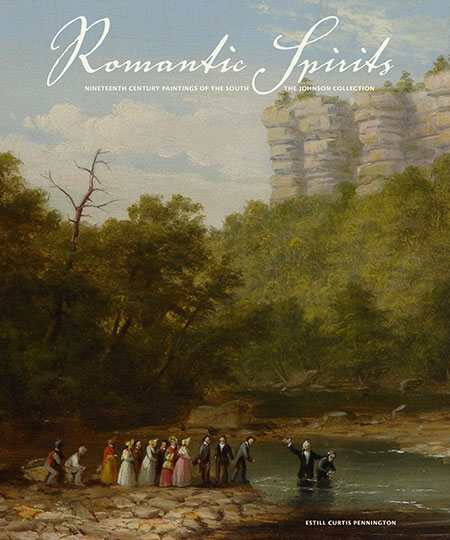Romantic Spirits
Nineteenth Century Paintings of the South, The Johnson Collection
An intriguing account of an art movement below the Mason-Dixon line, and what set it apart from Northern counterparts.
Romantic Spirits: Nineteenth Century Paintings of the South, The Johnson Collection is by the esteemed Southern art historian and author, Estill Curtis Pennington. Published as the companion to a traveling exhibition, this is the inaugural publication from The Johnson Collection in Spartanburg, South Carolina.
Many exhibition companion books are pretty to look at and sometimes provide general information about the artist(s) and works. Romantic Spirits is an intriguing account of an art movement from the mid to late 1800s below the Mason-Dixon line. Pennington creates context throughout his introduction and in each description and biography of the thirty-two artists. The author presents a balanced view of how Romanticism evolved in the North and the South, the genre’s ties to Europe, and how culture, customs, education, and travel influenced each artist.
Pennington’s prose is neither academic nor laden with art world jargon. Each artist is well described, as are the accompanying images in accessible language that does not talk down to the reader. For the reader who is savvy in art history, it is filled with enough detail and contextual information tying the painter to his contemporaries, specifically authors and poets, including William Faulkner, Harriet Beecher Stowe, Henry Wadsworth Longfellow, among others.
“That the Southern heroic individual lived out his life with a very palpable, imaginative and often delusional value system has long been a cornerstone of Southern studies,” writes Pennington. “A grave sense of honor, the pursuit of gentlemanly virtue with chivalric intent and a distinct determination to set aside the more pressing demands of the immediate world in deference to abstract idealism lent vivid color to the romantic spirits.”
The questions of slavery and race are threaded through the artists’ biographies. Pennington gives readers a brief but passionate bio of Harriet Beecher Stowe and her acclaimed 1851 novel, Uncle Tom’s Cabin. He evens out the score by introducing readers to William John Grayson. “While there can be no doubt that slavery was a grave ill, Grayson was the first of sequential generations of writers to question whether the state of the industrial work tooling in the North was any better.”
Pennington defines what sets apart Southern painters of the nineteenth century Romantic Movement from their Northern counterparts, “An awareness of the vitality of the oral tradition and an understanding of the deep-seated importance of place are critical to an understanding of the romantic spirit of the South. Southerners tell stories to preserve family history, to leave the mundane with wit and to reinforce personal ideology.”
A scholarly work but interesting enough for Civil War history buffs, art history students, educators and art professionals. Detailed biographies and a bibliography complete the book that may be enjoyed by readers whether or not they have seen the exhibition or visited The Johnson Collection.
Pennington, an award-winning author, has served as curator at the Smithsonian Institution, National Portrait Gallery and New Orleans Museum of Art. Previous publications include: William Edward West, Kentucky Painter, and Currents of Style in Louisiana Art, 1800-1950. A recipient of the Kentucky Historical Society’s Award of Merit, Pennington is the co-editor of the New Encyclopedia of Southern Culture; Art & Architecture to be published by the University Press of North Carolina.
Reviewed by
Dindy Yokel
Disclosure: This article is not an endorsement, but a review. The publisher of this book provided free copies of the book and paid a small fee to have their book reviewed by a professional reviewer. Foreword Reviews and Clarion Reviews make no guarantee that the publisher will receive a positive review. Foreword Magazine, Inc. is disclosing this in accordance with the Federal Trade Commission’s 16 CFR, Part 255.

